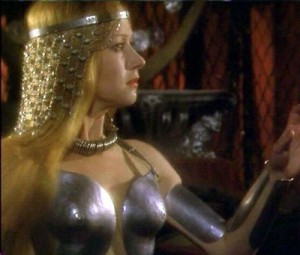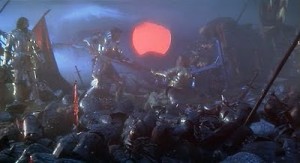 It’s what many people, myself included, consider to be the definitive telling of the King Arthur legend. It introduced a new generation to the massive choral piece “O Fortuna” from Carl Orff’s Carmina Burana
It’s what many people, myself included, consider to be the definitive telling of the King Arthur legend. It introduced a new generation to the massive choral piece “O Fortuna” from Carl Orff’s Carmina Burana![]() . Beyond that, it also made my 16-year-old self seek out the music of Richard Wagner. 30 years ago, on April 10, 1981, Excalibur
. Beyond that, it also made my 16-year-old self seek out the music of Richard Wagner. 30 years ago, on April 10, 1981, Excalibur![]() was released.
was released.
Director John Boorman at the time was best known for the brilliant and disturbing Oscar-nominated Deliverance![]() (1972). Boorman had been trying to make a film about the Arthurian legend since the late sixties and at one point was even preparing a film version of The Lord of the Rings instead — in fact he and Excalibur co-writer Rospo Pallenberg had collaborated on a Lord of the Rings screenplay which would have condensed all three of J. R. R. Tolkien’s novels one movie. When that project fell through, Boorman turned his thoughts back to King Arthur.
(1972). Boorman had been trying to make a film about the Arthurian legend since the late sixties and at one point was even preparing a film version of The Lord of the Rings instead — in fact he and Excalibur co-writer Rospo Pallenberg had collaborated on a Lord of the Rings screenplay which would have condensed all three of J. R. R. Tolkien’s novels one movie. When that project fell through, Boorman turned his thoughts back to King Arthur.
The screenplay for Excalibur, adapted by Boorman and Rospo Pallenberg from Thomas Malory’s Le Morte d’Arthur, focuses more on allegory and myth than historical accuracy. But, as strange as the tale is at times, it never strays too far from realism. It also manages to cover the major moments of the legend — the betrayal of Lancelot and Guinevere, the rise of Mordred, the quest for the Holy Grail — without seeming rushed.
I think what stood out for me the most when I saw it opening weekend was that the film portrayed medieval combat unlike anything I had ever seen before — with brutal realism. A knight in full plate armor can barely move, let alone fight, and the swords they use are so heavy that a sword fight is less like a fencing match and more like ferociously slashing away at your opponent’s armor until eventually you hack your way through.
The cast assembled here is outstanding. Noted character actor Nicol Williamson, at the time best known for his bold and brilliant take as Sherlock Holmes in The Seven-Per-Cent Solution (1976), gives a wonderfully eccentric performance as Merlin, who weaves in and out of the story, setting things in motion with great wisdom and confidence, yet showing genuine shock when events occur that he did not foresee (an example of which is seen at the end of the clip below).[kml_flashembed movie="http://www.youtube.com/v/dURNAFRTsVw" width="600" height="344" allowfullscreen="true" fvars="fs=1" /]
 Nigel Terry, known primarily for his stage work, is a perfect King Arthur, playing him convincingly through a wide range of years. And the stunning-at-any-age Helen Mirren is captivating as Morgana, Arthur’s half-sister and also his son’s mother (yes, you read that right). Also flawless in their roles are Nicholas Clay as Sir Lancelot and Cherie Lunghi as Queen Guinevere. These are all easily my favorite portrayals of these mythic characters ever filmed.
Nigel Terry, known primarily for his stage work, is a perfect King Arthur, playing him convincingly through a wide range of years. And the stunning-at-any-age Helen Mirren is captivating as Morgana, Arthur’s half-sister and also his son’s mother (yes, you read that right). Also flawless in their roles are Nicholas Clay as Sir Lancelot and Cherie Lunghi as Queen Guinevere. These are all easily my favorite portrayals of these mythic characters ever filmed.
Excalibur was the film debuts of Gabriel Byrne (as Arthur’s father Uther Pendragon), Liam Neeson (as Sir Gawain), and Patrick Stewart (as Leondegrance, who is the first to overdramatically attempt to draw the sword from the stone and is also the first ally of the boy king).
 The gorgeous Oscar-nominated cinematography is by Alex Thomson, who went on to shoot Ridley Scott’s Legend
The gorgeous Oscar-nominated cinematography is by Alex Thomson, who went on to shoot Ridley Scott’s Legend![]() (1985). For Excalibur he uses a striking green lighting effect whenever the titular sword of power is featured. The film also contains unforgettable background imagery such as the the massive flames of the fire during the night Arthur is conceived and the red glow of the sun during the climactic confrontation between Arthur and Mordred.
(1985). For Excalibur he uses a striking green lighting effect whenever the titular sword of power is featured. The film also contains unforgettable background imagery such as the the massive flames of the fire during the night Arthur is conceived and the red glow of the sun during the climactic confrontation between Arthur and Mordred.
I’ll leave you with this small bit from John Boorman’s DVD commentary track as Perceval (Paul Geoffrey) begins his quest for the Holy Grail: “This scene of finding the dead knight … I really stole this idea from The Seventh Seal, from Bergman. He did it much better.”[kml_flashembed movie="http://www.youtube.com/v/emF-m9qnF5o" width="600" height="344" allowfullscreen="true" fvars="fs=1" /]




Comments